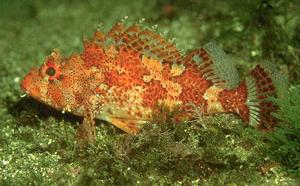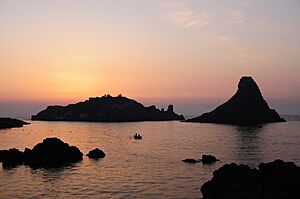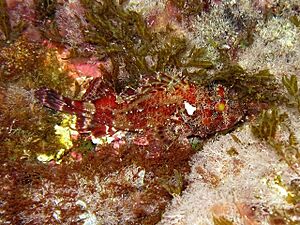Madeira rockfish facts for kids
Quick facts for kids Madeira rockfish |
|
|---|---|
 |
|
| Scorpaena maderensis in the waters off Croatia | |
| Conservation status | |
| Scientific classification | |
| Synonyms | |
|
The Madeira rockfish (Scorpaena maderensis) is a type of scorpionfish. These fish live in the coastal waters of the eastern Atlantic Ocean and the Mediterranean Sea. They belong to a group of fish called Scorpaenidae.
This fish can grow to about 14 centimetres (5.5 in) long. The Madeira rockfish was first described in 1833 by a scientist named Achille Valenciennes. He studied a fish found near Madeira, an island in the Atlantic. Even though these fish are common in their habitats, scientists are still learning about their lives.
Contents
About the Madeira Rockfish
The Madeira rockfish is a small fish. It usually grows between 4.8 cm (1.89 in) and 13.1 cm (5.16 in) long. Males tend to be larger than females.
These fish have many features similar to other scorpionfish. They have spiny fins and a reddish-brown color with blotches. This coloring helps them blend in with their surroundings.
Venomous Spines
One important feature of the Madeira rockfish is its venomous spines. These spines have a special groove that holds venom. If you touch these spines, the venom can cause health problems. It is important to be careful around them.
Where Madeira Rockfish Live
The Madeira rockfish lives in rocky coastal areas. You can find them along the northwestern coast of Africa. They also live in the Mediterranean Sea and around islands in the eastern Atlantic.
These fish are known as "cryptobenthic." This means they live on or near the seafloor (benthic). They also like to hide in cracks and crevices (cryptic). This helps them hunt for food and stay safe from predators.
Preferred Habitat
Madeira rockfish hide in the rocky bottoms of the ocean. This allows them to ambush prey and stay hidden. It is hard to know exactly how many of these fish live in the Mediterranean Sea. This is because there is not enough information.
However, many studies have been done in the Cyclops Protected Marine Area near Sicily. In this area, the Madeira rockfish is the most common fish species. Scientists are still trying to figure out the exact depth these fish prefer. Some studies say 20 to 40 meters, while others say less than 7 meters. This difference is due to limited data.
What Madeira Rockfish Eat
The Madeira rockfish mainly eats small crustaceans. These include crabs, shrimp, and other tiny sea creatures. They sometimes also eat algae, snails, worms, and even other small fish.
These fish are "opportunistic feeders." This means they eat whatever food is available around them. Their diet can change from one fish to another. They often eat organisms that other fish do not usually target.
Seasonal Eating Habits
The Madeira rockfish's eating habits change with the seasons. They tend to eat more in the winter months. In the summer months, they eat less.
Madeira Rockfish and Humans
People sometimes catch the Madeira rockfish. This happens in small-scale fishing operations along the coasts. However, these fish are not in danger of being overfished. They are also not at risk of extinction.
Even though they are not endangered, fishing might affect their ability to reproduce. Also, because of their venomous spines, they can sting people. Divers, fishermen, and even swimmers need to be careful. It is important to take precautions to avoid getting injured.




